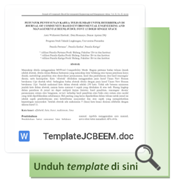Analysis of Building Sanitation And Cleaning Facilities Case Study of Environmental Service Company
DOI:
https://doi.org/10.23969/jcbeem.v6i1.5266Keywords:
analysis of building sanitation, importance performance analysis, sanitation attributeAbstract
This study aims to determine the sanitation conditions of buildings and cleaning facilities at an Environmental Services Company. In this research, the Importance Performance Analysis (IPA) mapping of each attribute of the assessment of the sanitation condition was evaluated so that it can be seen which assessment attributes have low values and need to be assessed to get corrective action as a top priority. This research is descriptive quantitative research by collecting data through direct observation and distributing questionnaires to all employees of the Environmental Services Company. The results of 20 respondents were processed using the SPSS 16 application. The results showed that the sanitation conditions of the buildings and cleaning facilities at the Environmental Service Company did not meet the requirements. Priority mapping of the sanitation attributes of buildings and cleaning facilities using the Importance Performance Analysis (IPA) method can be seen in the Cartesian diagram. The result shows that from all 17 building sanitation attributes, there are 3 attributes in quadrant A. While 7 attributes are in quadrant B, 3 attributes are in quadrant C, and 3 attributes are in quadrant D. Of the 46 sanitation attributes for sanitation facilities, there are 8 attributes in quadrant A, 24 attributes in quadrant B, 13 attributes in quadrant C, and 1 attribute in quadrant D. Attributes that have low scores on building sanitation, namely the yard and roof of the building, while in sanitation of cleaning facilities, namely lockers in the changing room, trash cans, and sanitary napkins.
Downloads
References
Asfary, O.R. (2018). Analisis Kepuasan Pelanggan Menggunakan Pendekatan Importance Performance Analysis dan Customer Satisfaction Index (Studi Kasus pada Puskemas Pkem Yogyakarta). Skripsi. Yogyakarta: Universitas Islam Indonesia Yogyakata.
Azizah, N.R, Puspikawati, S.I., and Oktanova, M.A. (2018). Inspeksi Kesehatan Lingkungan Sekolah Dasar Di Kabupaten Banyuwangi. Journal of Public Health Research and Community Health Development, 2 (1): 11-21.
Celesta, A.G & Fitriyah, N. (2016). Gambaran Sanitasi Dasar di Desa Payaman, Kabupaten Bojonegoro Tahun 2016. Jurnal Kesehatan Lingkungan, 11(2): 83:90.
Gea, M. (2020). Analisis Tingkat Kepuasan Pelayanan PT BNI Syariah Cabang Medan dengan Importance Performance Analysis (IPA). Skripsi. Medan: Universitas Islam Negeri Sumatera Utara.
Ministry of Manpower of the Republic of Indonesia. (2018). Regulation of the Minister of Manpower of the Republic of Indonesia Number 5 of 2018 concerning Occupational Safety and Health in the Work Environment.
Safitri, A.D. (2020). Analisis Kondisi Sanitasi Lingkungan dan Perilaku Hidup Bersih dan Sehat (PHBS) di Sekolah Dasar Kecamatan Gunungpati. Skripsi. Semarang: Universitas Negeri Semarang.
Sunarsa, I.W. and Darmawijaya, I.G. (2014). Kualitas Kebersihan, Fasilitas, Desain Dan Pengelolaan Toilet Umum Pada Daya Tarik Wisata di Bali. Jurnal Ilmiah Pariwisata, 19(3): 229-245.
Surahman, U. (2010). Rancangan Kegiatan Pembelajaran Mata Kuliah Mekanikal dan Elektrikal. Bandung: Universitas Pendidikan Indonesia.
Suryani, A.S. (2020). Pembangunan Air Bersih dan Sanitasi saat Pandemi Covid-19. Aspirasi: Jurnal Masalah-Masalah Sosial, 11(2): 199-214.














